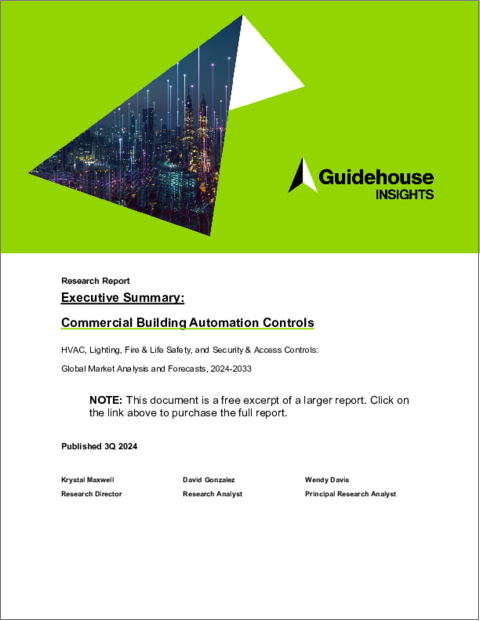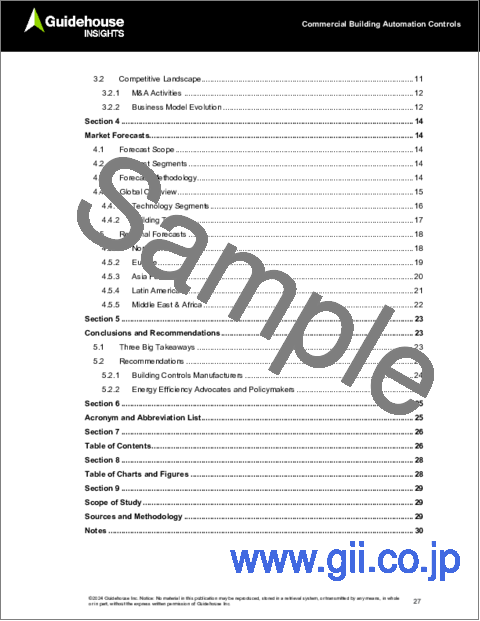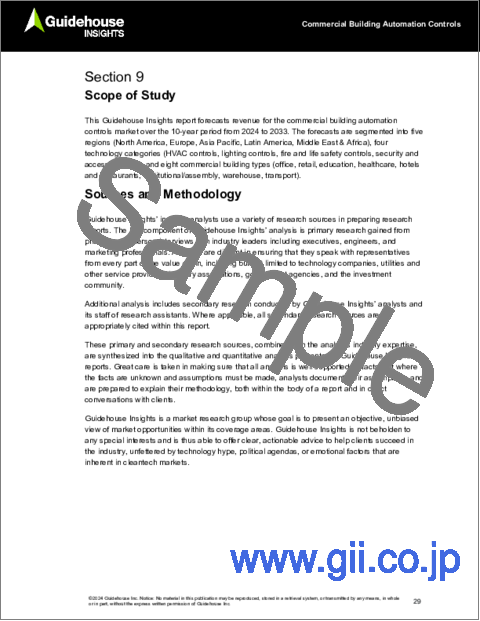|
|
市場調査レポート
商品コード
1511766
商業用ビルオートメーション制御 - HVAC、照明、防火・救命、警備・アクセス制御:世界市場の分析と予測 (2024~2033年)Commercial Building Automation Controls - HVAC, Lighting, Fire & Life Safety, and Security & Access Controls: Global Market Analysis and Forecasts, 2024-2033 |
||||||
|
|||||||
| 商業用ビルオートメーション制御 - HVAC、照明、防火・救命、警備・アクセス制御:世界市場の分析と予測 (2024~2033年) |
|
出版日: 2024年07月10日
発行: Guidehouse Research
ページ情報: 英文 31 Pages; 46 Tables, Charts & Figures
納期: 即納可能
|
全表示
- 概要
- 図表
- 目次
企業がエネルギー消費量と二酸化炭素排出量の削減を目指す中、商業用ビルオートメーション制御の需要は過去10年間で増加しています。HVAC、照明、防火・防災、セキュリティ、アクセス制御などの技術を自動化することで、ビルオーナーや施設管理者は、エネルギー消費の効率化、緊急事態への対応時間の短縮、より健康的な居住環境の実現などのメリットが得られることに気づいています。建築物技術の最新の進歩は、リアルタイム通信を可能にし、建築物環境の変化への対応を自動化する単一のインターフェイスを通じて、すべてのビルシステムを接続・管理する能力を促進してきました。
エネルギー価格の変動、持続可能性に関する利害関係者からの圧力、法的義務、スペース利用の最適化の必要性などの要因により、世界中の各種企業・組織によりスマートな統合システムへの移行は近年加速しています。さらに、商業用ビルオートメーション技術ベンダーは、サードパーティのビル管理システムにシームレスに統合できるオープン通信プロトコルと組み合わせたスマートシステムを開発し、自動化技術をより簡単かつ迅速に展開できるようになりました。顧客需要の増加と、より簡単に統合できる技術の組み合わせにより、商業用ビルオートメーション制御の市場規模は拡大しています。
当レポートでは、世界の商業用ビルオートメーション制御の市場について包括的に分析し、昨今の市場の主な動向や促進・抑制要因、全体的な市場動向の見通し (今後10年間分)、地域別 (北米、欧州、アジア太平洋、ラテンアメリカ、中東・アフリカ)・技術別 (HVAC制御、照明制御、防火・救命制御、警備・アクセス制御)・建築物の種類別 (オフィス、小売店、教育施設、医療施設、ホテル・レストラン、公的機関/会議場、倉庫、交通機関) の詳細動向などを調査しております。
目次
第1章 エグゼクティブサマリー
第2章 市場の問題
- 市場動向
- スマート建築物に対する居住者の期待の進化
- 既存のセンサーへの統合の複雑さ
- 施設管理における熟練労働者の不足
- SECの気候変動情報開示提言
- 企業持続可能性報告指令
- 促進要因
- 法律上の義務と建築基準
- エネルギー価格変動への耐性
- 居住者の健康と幸福 (ウェルビーイング)
- ユーティリティからのインセンティブと割引
- パフォーマンス契約の普及
- 抑制要因
- 高コスト
- サプライチェーンの問題
- 新規建設の減速
- 新規システムの複雑さ
- サイバーセキュリティの懸念
- 価格
第3章 産業バリューチェーン
- バリューチェーン
- 競合情勢
- 企業合併・買収 (M&A) 活動
- ビジネスモデルの進化
第4章 市場予測
- 予測範囲
- 予測セグメント
- 予測手法
- 世界市場の概要
- 技術セグメント
- 建物の種類
- 地域別の予測
- 北米
- 欧州
- アジア太平洋
- ラテンアメリカ
- 中東・アフリカ
第5章 結論・提言
- 3つの大きなポイント
- 推奨事項
- ビル制御機器メーカー
- 省エネ推進者と政策立案者
第6章 頭字語と略語一覧
第7章 目次
第8章 図表
第9章 調査範囲
第10章 情報源、調査手法、注釈
List of Tables
- Commercial Building Automation Controls Revenue by Region, World Markets: 2024-2033
- Commercial Building Automation Controls Revenue by Technology, World Markets: 2024-2033
- Commercial Building Automation Controls Revenue by Building Type, World Markets: 2024-2033
- HVAC Controls Revenue by Building Type, World Markets: 2024-2033
- Lighting Controls Revenue by Building Type, World Markets: 2024-2033
- Fire and Life Safety Controls Revenue by Building Type, World Markets: 2024-2033
- Security and Access Controls Revenue by Building Type, World Markets: 2024-2033
- Commercial Building Automation Controls Revenue by Technology, North America: 2024-2033
- Commercial Building Automation Controls Revenue by Building Type, North America: 2024-2033
- HVAC Controls Revenue by Building Type, North America: 2024-2033
- Lighting Controls Revenue by Building Type, North America: 2024-2033
- Fire and Life Safety Controls Revenue by Building Type, North America: 2024-2033
- Security and Access Controls Revenue by Building Type, North America: 2024-2033
- Commercial Building Automation Controls Revenue by Technology, Europe: 2024-2033
- Commercial Building Automation Controls Revenue by Building Type, Europe: 2024-2033
- HVAC Controls Revenue by Building Type, Europe: 2024-2033
- Lighting Controls Revenue by Building Type, Europe: 2024-2033
- Fire and Life Safety Controls Revenue by Building Type, Europe: 2024-2033
- Security and Access Controls Revenue by Building Type, Europe: 2024-2033
- Commercial Building Automation Controls Revenue by Technology, Asia Pacific: 2024-2033
- Commercial Building Automation Controls Revenue by Building Type, Asia Pacific: 2024-2033
- HVAC Controls Revenue by Building Type, Asia Pacific: 2024-2033
- Lighting Controls Revenue by Building Type, Asia Pacific: 2024-2033
- Fire and Life Safety Controls Revenue by Building Type, Asia Pacific: 2024-2033
- Security and Access Controls Revenue by Building Type, Asia Pacific: 2024-2033
- Commercial Building Automation Controls Revenue by Technology, Latin America: 2024-2033
- Commercial Building Automation Controls Revenue by Building Type, Latin America: 2024-2033
- HVAC Controls Revenue by Building Type, Latin America: 2024-2033
- Lighting Controls Revenue by Building Type, Latin America: 2024-2033
- Fire and Life Safety Controls Revenue by Building Type, Latin America: 2024-2033
- Security and Access Controls Revenue by Building Type, Latin America: 2024-2033
- Commercial Building Automation Controls Revenue by Technology, Middle East & Africa: 2024-2033
- Commercial Building Automation Controls Revenue by Building Type, Middle East & Africa: 2024-2033
- HVAC Controls Revenue by Building Type, Middle East & Africa: 2024-2033
- Lighting Controls Revenue by Building Type, Middle East & Africa: 2024-2033
- Fire and Life Safety Controls Revenue by Building Type, Middle East & Africa: 2024-2033
- Security and Access Controls Revenue by Building Type, Middle East & Africa: 2024-2033
List of Figures
- Commercial Building Automation Controls Revenue by Region, World Markets: 2024-2033
- Commercial Building Automation Controls Revenue by Technology, World Markets: 2024-2033
- Commercial Building Automation Controls Revenue by Building Type, World Markets: 2024-2033
- Commercial Building Automation Controls Revenue by Technology, North America: 2024-2033
- Commercial Building Automation Controls Revenue by Technology, Europe: 2024-2033
- Commercial Building Automation Controls Revenue by Technology, Asia Pacific: 2024-2033
- Commercial Building Automation Controls Revenue by Technology, Latin America: 2024-2033
Commercial Building Automation Controls Revenue by Technology, Middle East & Africa: 2024-2033"
Commercial Building Automation Controls Value Chain
The demand for commercial building automation controls has been growing over the past decade as organizations aim to reduce their energy consumption and carbon footprint. By automating technologies such as HVAC, lighting, fire and life safety, and security and access controls, building owners and facility managers have realized they can achieve benefits such as more efficient energy consumption, increased response times to emergencies, and a healthier occupant environment. The latest advances in building technologies have facilitated the ability to connect and manage all building systems through a single interface that enables real-time communication and automates responses to changes in the building environment.
The transition by organizations worldwide toward smart, integrated systems has accelerated in recent years due to factors such as energy price volatility, sustainability stakeholder pressures, legislative obligations, and the need to optimize space utilization. In addition, commercial building automation technology vendors have been able to develop smart systems paired with open communications protocols that can seamlessly integrate into third-party building management systems and allow for easier and faster deployment of automated technologies. The combination of increased customer demand with more easily integrated technologies has resulted in a growing market size for commercial building automation controls.
This Guidehouse Insights report provides a comprehensive analysis of the commercial building automation controls market, covering the trends, drivers, and barriers that have shaped its evolution in recent years. Additionally, it presents a 10-year forecast, offering insights into the future trajectory of the market across five global regions (North America, Europe, Asia Pacific, Latin America, Middle East & Africa), four technology segments (HVAC controls, lighting controls, fire and life safety controls, security and access controls), and eight commercial building types (office, retail, education, healthcare, hotels and restaurants, institutional/assembly, warehouse, transport).
Table of Contents
1. Executive Summary
- 1.1 Market Overview
- 1.2 Market Drivers
- 1.3 Market Barriers
- 1.4 Market Forecast
2. Market Issues
- 2.1 Market Trends
- 2.1.1 Evolving Occupant Expectations for Smart Buildings
- 2.1.2 Complexity of Integrating into Existing Sensors
- 2.1.3 Shortage of Skilled Labor in Facility Management
- 2.1.4 SEC Climate Disclosure Proposal
- 2.1.5 Corporate Sustainability Reporting Directive
- 2.2 Drivers
- 2.2.1 Legislative Obligations and Building Codes
- 2.2.2 Resilience to Energy Price Volatility
- 2.2.3 Occupant Health and Well-Being
- 2.2.4 Incentives and Rebates from Utilities
- 2.2.5 Wider Adoption of Performance Contracts
- 2.3 Barriers
- 2.3.1 High Costs
- 2.3.2 Supply Chain Issues
- 2.3.3 Slowdown of New Construction
- 2.3.4 Complexity of New Systems
- 2.3.5 Cybersecurity Concerns
- 2.4 Pricing
3. Industry Value Chain
- 3.1 Value Chain
- 3.2 Competitive Landscape
- 3.2.1 M&A Activities
- 3.2.2 Business Model Evolution
4. Market Forecasts
- 4.1 Forecast Scope
- 4.2 Forecast Segments
- 4.3 Forecast Methodology
- 4.4 Global Overview
- 4.4.1 Technology Segments
- 4.4.2 Building Types
- 4.5 Regional Forecasts
- 4.5.1 North America
- 4.5.2 Europe
- 4.5.3 Asia Pacific
- 4.5.4 Latin America
- 4.5.5 Middle East & Africa
5. Conclusions and Recommendations
- 5.1 Three Big Takeaways
- 5.2 Recommendations
- 5.2.1 Building Controls Manufacturers
- 5.2.2 Energy Efficiency Advocates and Policymakers






